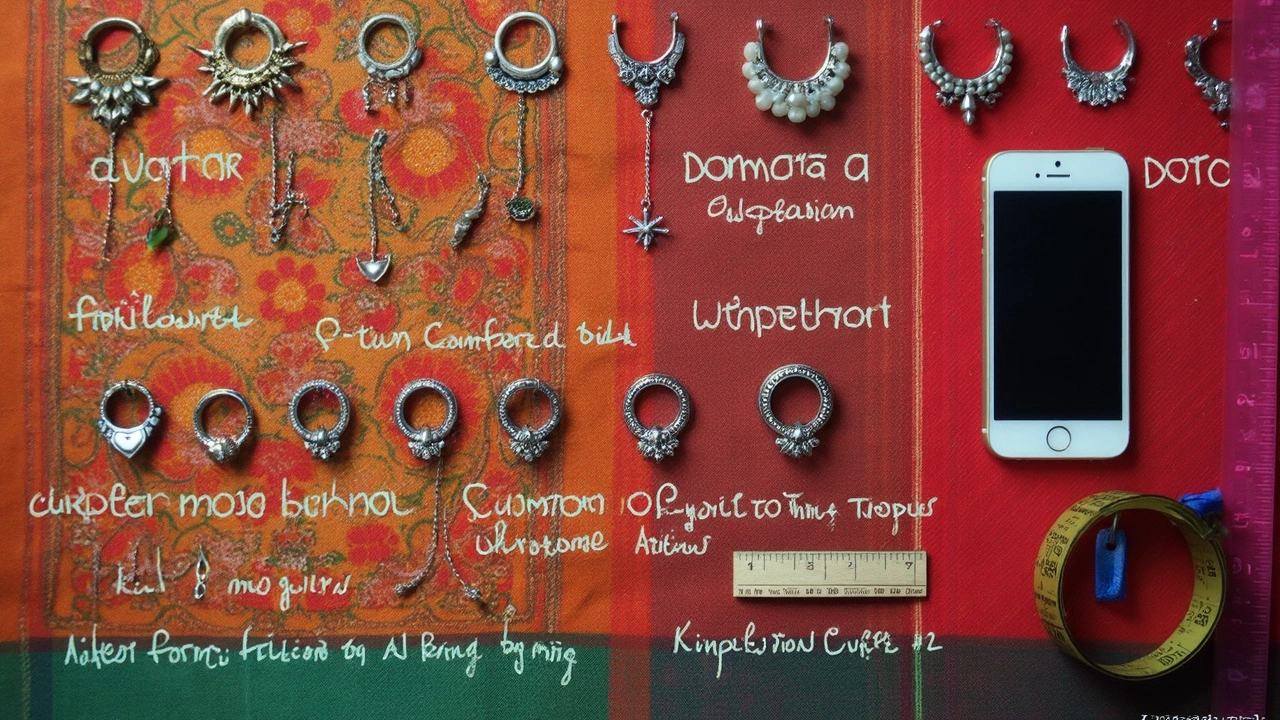
If you've ever tried to buy a new nose ring and had no clue what size fits, you're not alone. Many people just stick with the size their piercing studio gave them—but that doesn't always mean you have the right fit. Grab the wrong size and your jewelry could feel tight, poke out weirdly, or even fall out when you least expect it.
Most nose rings and studs come in a range of sizes, and the numbers can be confusing if you’re new to body jewelry. There’s the gauge (how thick the metal is) and the diameter or length (how “wide” the ring or how long the stud post is). Getting these wrong can mean pain, irritation, or just a look that doesn’t quite click with your style.
You don’t need a fancy jewelry kit to check your size. With a basic ruler or a small digital caliper, you can measure most nose jewelry at home. Even a bit of string or paper can work in a pinch when figuring out the diameter.
- Why Size Matters for Nose Rings
- Breaking Down Measurements: Gauge and Diameter
- Simple Ways to Measure Your Nose Jewelry
- Common Sizing Mistakes and How to Avoid Them
- Extra Tips for a Comfortable and Stylish Fit
Why Size Matters for Nose Rings
People usually underestimate how much picking the right nose ring size matters. Go too big or too small, and stuff starts going sideways—literally. If your nose ring is too tight, it can press against your skin, causing redness, swelling, or even a piercing bump. If it’s way too loose, it can slip out when you blow your nose or just vanish in your sleep. Neither feels great, and it can mess with both comfort and how your nose jewelry looks on your face.
Here’s the reality: sizing mistakes are super common. Most nose studs are sold in a couple of standard sizes—like 20 gauge (the thinnest and most common) or 18 gauge—but some shops and studios will use slightly thicker 16 gauge for new piercings, especially if you asked for extra strength or want to switch to a hoop soon.
| Gauge Size | Thickness (mm) | Typical Use |
|---|---|---|
| 20G | 0.8 | Standard nostril piercing |
| 18G | 1.0 | Heavier jewelry, initial piercing |
| 16G | 1.2 | Bigger hoops, some initial piercings |
Diameter and post length also have a big impact. Say your hoop is too wide—it will hang low, which looks odd and moves too much. If your stud has a post that's too short, it squishes the cartilage and never feels right. A longer post, meanwhile, can stick out and snag on everything. Even a difference of 1mm can throw off the fit.
Wearing the wrong size over time isn’t just annoying. It can mean your piercing doesn’t heal right, or it starts closing up around the jewelry. That’s why, for both style and health, getting your measurements spot-on truly pays off. Fact: Almost half of folks who end up with piercing bumps or irritation trace it back to a poorly-fitting piece—so yeah, size is a way bigger deal than people think.
Breaking Down Measurements: Gauge and Diameter
When people talk nose rings, two numbers matter most: gauge and diameter. Mixed up or ignore these and you risk sore nostrils or rings that wiggle out every time you sneeze. Here’s how it works.
Gauge is the thickness of the jewelry post or ring. In nose rings, sizes usually run from 18 gauge (thicker) to 22 gauge (thinner). But there’s a weird twist: as the gauge number goes up, the jewelry actually gets thinner. Yup, it’s a little backward.
Check out this quick breakdown of common nose ring gauges:
| Gauge | Inches | Millimeters |
|---|---|---|
| 18g | 0.040" | 1.0 mm |
| 20g | 0.032" | 0.8 mm |
| 22g | 0.025" | 0.6 mm |
Most people with fresh nostril piercings start with 18g or 20g. Older or fully healed piercings can sometimes handle 22g, which looks more delicate.
Now, let’s talk diameter—the width across the ring, not the thickness. For studs, you’ll hear “length” instead (how far the post goes into your nostril). Standard nose ring diameters range from 6mm to 10mm, with 8mm being the most common for average nostrils. If the ring is too small, it can pinch or look too tight, and if it’s too big, it slides down and looks floppy.
When shopping or measuring your own jewelry, double check both gauge and diameter/length. It’s not unusual to find the look you want in a style that’s the wrong size. The nose ring size isn’t about fashion—if it doesn’t fit, it’s not going to work, period.
- The gauge fits your piercing hole—too thick means pain; too thin can fall out.
- The diameter or length needs to match how deep your nostril is and how much you want the ring to hug your nose.
- Jewelry packs online often mix up gauges, so read labels carefully.

Simple Ways to Measure Your Nose Jewelry
If you want to know your nose ring size for sure, you’ll need two main measurements: gauge (thickness of the post or hoop) and inner diameter (how wide the ring sits in your nose). Knowing these makes shopping so much easier, especially if you’re looking to upgrade your nose ring size or try out new nose pin designs.
Start by cleaning the jewelry. Even if you just wore it, give it a quick wash and dry before measuring. Oils or gunk can actually add to the thickness on a small item like a nose stud.
- Gauge (thickness): Use a digital caliper if you have one. If not, line up the post with a ruler and look at the millimeter marks. The most common gauges are 18G (1.0 mm thick), 20G (0.8 mm), and sometimes 22G (0.6 mm). If you’re checking at home, match the post with sewing needles or wire gauges if you have a crafty kit—they’re marked too.
- Diameter (hoops): Grab a ruler, tape measure, or a piece of string. For hoops, measure straight across the inside of the ring, not the outside. Wrap the string around if needed, then measure the string next to a ruler for the exact number.
- Post Length (studs): For straight nose pins, just line the jewelry up next to a ruler for a quick check. Most range from 6mm to 8mm but it can vary. If in doubt, shorter is usually less likely to poke against the inside of your nose.
Here’s a quick cheat-sheet to help you spot the most common nose ring sizes in millimeters (mm) and gauge (G):
| Gauge (G) | Thickness (mm) | Common Use |
|---|---|---|
| 18G | 1.0 mm | Standard/initial piercing |
| 20G | 0.8 mm | Standard, low-profile jewelry |
| 22G | 0.6 mm | Super thin, delicate pins |
If you can’t measure your jewelry (say, you lost it), you can ask your piercing studio or check your original purchase info—shops often record the gauge and size for repeat buyers. And if you’re between sizes or want a snug fit, size down for the hoop diameter or post length, but never force a smaller gauge because that can damage your piercing.
Common Sizing Mistakes and How to Avoid Them
You’d be surprised how many people guess their nose ring size and end up with jewelry that’s either too tight or practically falling out. One of the most common slip-ups? Mixing up the gauge, especially if you’re ordering online. It’s easy to think all nose rings are the same thickness, but they’re absolutely not. Standard gauges for nose piercings are usually 18G (1.0mm) or 20G (0.8mm), but some people get pierced with a 22G (0.6mm) for a super thin look. A thicker gauge than your actual piercing can be nearly impossible to insert, while a thinner one might feel loose and can even cause the hole to shrink.
Another big mistake is confusing diameter with post length. Diameter matters if you’re wearing a hoop—go too small and the ring pulls at your skin, go too large and it dangles awkwardly. With studs, the post should be long enough to sit comfortably on the inside but not so long it pokes your nose every time you smile. The most common hoop diameter is 8mm, but some may need 6mm or 10mm, depending on nostril shape and piercing location.
Here’s where people often go wrong:
- Picking jewelry based on how it looks in photos instead of checking the actual measurements listed.
- Measuring their old jewelry after it’s already bent out of shape.
- Relying only on memory (“I think it was a 20G?”) without double-checking.
- Assuming all nostrils and piercings are the same, when really everyone’s anatomy is a bit different.
If you want to avoid these headaches, follow these tips:
- Use a caliper or a millimeter ruler to measure both the gauge and the diameter of a piece that fits you well.
- If you don’t have an old ring to measure, check the paperwork from your piercing studio—most shops include the original gauge and length.
- If you’re buying a new style, ask the seller for actual sizes and compare them to what you know fits.
- If in doubt, go to a professional piercer—they can measure you in minutes and help prevent expensive, uncomfortable mistakes.
Dialing in your nose ring size might seem like a hassle, but skipping these steps is what leads to most fitting disasters. Take an extra minute to measure or get measured, and you’ll avoid 99% of the problems people run into when shopping for nose jewelry.

Extra Tips for a Comfortable and Stylish Fit
Nobody wants their nose ring to irritate skin or feel awkward. Even if you know your size, small tricks can make all the difference when it comes to comfort and style.
- Go for hypoallergenic materials if your skin gets red or itchy. Surgical steel, titanium, and 14k gold are safe bets. Nickel allergies send loads of people back to the piercer every year.
- Always double-check the shape of the post. Some studs have L-shaped bars, others are straight, and screws twist in. If your nose ring keeps falling out, switch up the style, not just the size.
- Don’t force thicker jewelry through a fresh or tight piercing. Most people feel best with a 20 or 18 gauge, but listen to your skin—swelling or pain means it’s too thick.
- Wearing a hoop? Check the diameter. Too big and it swings all over; too small and it pinches. The “average” comfortable inside diameter for a nostril hoop is about 8mm, but check your own measurement before ordering.
- See a professional if your nose feels sore, your jewelry sinks in, or you keep battling bumps. Sometimes it’s not the size or style—your body just needs a reset.
If you’re curious about what most folks wear, check out the most popular gauge and diameter combos in the table below:
| Jewelry Type | Common Gauge | Typical Diameter/Post Length |
|---|---|---|
| Stud | 20G (0.8mm) | 6mm - 7mm |
| Hoop | 18G (1.0mm) | 7mm - 9mm |
| Screw | 20G (0.8mm) | 6mm - 7mm |
Lastly, match your nose jewelry to your daily routine. If you move a lot, play sports, or wear masks often, stick with studs or screws that sit close to your nostril. Save the big statement hoops for nights out or times when you want your look to stand out.



